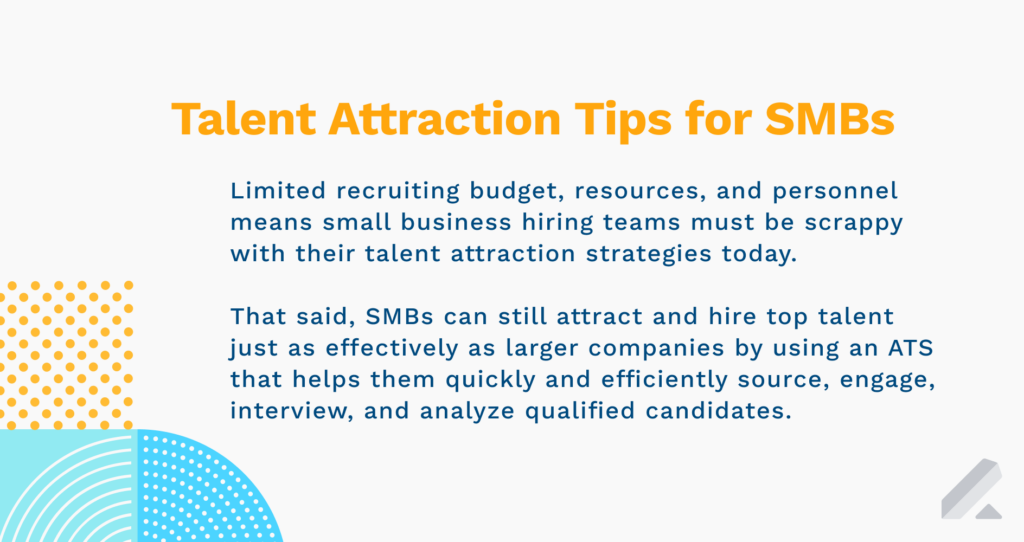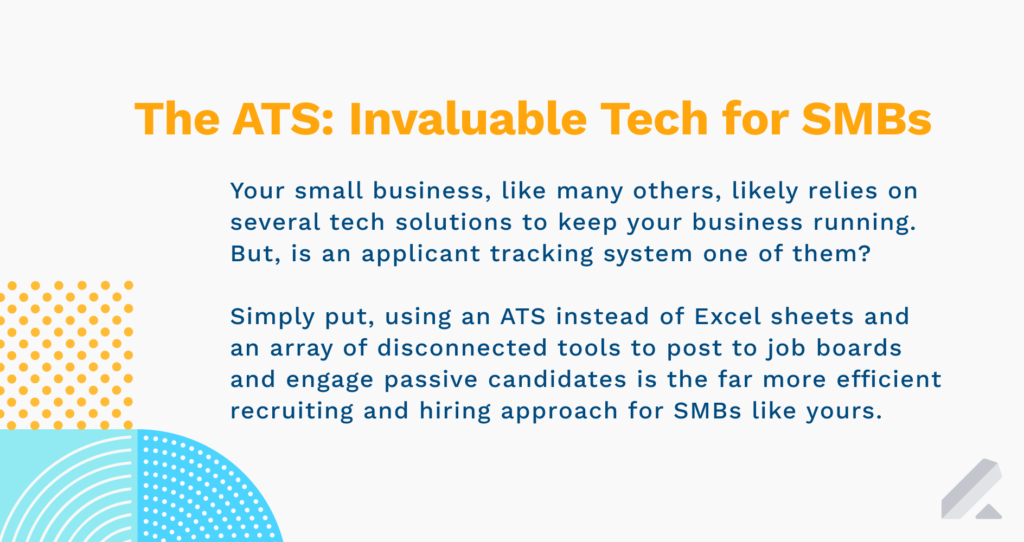Your small business may not have high-volume hiring needs like bigger companies. But you do likely have similar talent attraction goals. For example, both larger enterprises and SMBs must:
- Connect with active job seekers to apply for open roles and engage passive candidates
- Build hiring processes that efficiently move candidates from one recruiting stage to the next
- Explain why their companies are great to work for through employer branding activities
- Regularly improve their recruitment processes to ensure they connect with the right candidates
While your talent attraction strategy will not match the size and scale of larger companies, your hiring team can still recruit top talent effectively with the right approach and technology.

8 talent attraction tips for your small business
The labor market has been especially hard on small businesses, many of which had limited recruiting and hiring resources, and were already stretched thin.
National Federation of Independent Business (NFIB) research found roughly half of SMBs have struggled to fill roles. More than 90% of small business owners surveyed by NFIB cited few or no applicants for their open roles.
However, this is some encouraging news. Bankrate’s 2023 Job Seekers Survey found 56% of the workforce is either currently looking for new jobs or will in 2024. That’s up from 51% the year before.
Despite having more potential employees to consider for available roles, your SMB hiring team can’t assume you’ll automatically increase the size of your talent pool.
Rather, you must assess and improve your talent attraction approach often to beat out other employers for qualified candidates. Here are several tips and tricks that can help you attract job seekers and fill key roles across your SMB.

1) Routinely refresh your ideal candidate profile
Your company may only have a few types of positions you need to fill. Despite this narrow set of roles, it’s still ideal to create ideal candidate profiles (ICP) for each one.
An ICP is like a customer persona. Instead of figuring out who your target buyer is, though, you and other hiring stakeholders define what your perfect job candidate looks like.
Crafting dedicated ICPs can give your recruiters a road map of sorts regarding how to best attract that kind of talent.
“By collaborating internally to define ideal candidate profiles … you can gain a significant advantage in attracting top talent, reducing turnover and ultimately achieving [your] business objectives,” Forbes Human Resources Council member Smarthveer Sidana recently wrote.
2) Ensure your hiring team is on the same page
Creating defined ICPs is a great starting point to ensure your hiring team is aligned. But it’s just a starting point. There are other elements of your talent acquisition approach to address so your recruiters and hiring managers work seamlessly with one another.
Take job descriptions. Your hiring manager has certain qualifications they look for in candidates. But hiring managers must relay all those must-haves and the desired impact new hires will have on the team and the business with HR specialists who write job descriptions.
Fail to do so, and some job seekers who apply for open roles won’t end up being strong fits.
“Lack of alignment and clarity on role expectations among … the hiring team may [keep] you from recruiting and hiring the best,” said Gallup Director of Hiring Analytics Kristin Barry.

3) Promote your stellar organizational culture
Does your small business offer flexible working options, like hybrid or remote work? Do employees feel they have a strong work-life balance? Are there learning and development opportunities? Have employees been able to grow at your SMB?
If the answer to these questions is yes, include mentions of these employee benefits on your company’s career and About pages, social media presence, and profiles on job boards and career communities where you publish job postings.
Employer branding is all about promoting your SMB to attract top talent.
Show job seekers why they should apply for open roles by sharing how much your employees enjoy working at the company and the long-term career growth opportunities they have.
4) Explain what your interview process entails
This may not seem like a talent attraction tactic, but some job seekers actually base their decision on whether to apply for a job or not on whether they can get insights into the potential interview structure.
Use your career site to detail each interview process stage, who candidates typically speak to during each one, how long the overall process takes, if there are any pre-employment assessments involved, and any other info you think candidates must know.

5) Make it easy for job seekers to apply for roles
Adding details about your interview structure won’t help your small business increase your application completion rate if would-be applicants find it hard to apply for your job openings.
Your application process must be frictionless and quick for candidates to complete.
“Given the recruitment marketing expenditure involved in attracting qualified talent … having unnecessary roadblocks in place is counterintuitive and creates friction in the apply flow,” technology and marketing expert Karl Wierzbicki told SHRM.
6) Proactively reach out to passive candidates
Optimizing your career page, postings, and other recruitment marketing activities to secure more applications is a must. But your HR team must also proactively contact passive candidates whose profiles on LinkedIn and other career communities show they are strong fits.
Just be sure you source a diverse array of talent. With recruiting software like Lever, you can send diversity and Equal Employment Opportunity (EEO) surveys, then analyze your data in Visual Insights to see if you have candidates of different genders, races, ages, and other diversity traits.
If you don’t have as many diverse candidates as you’d like in your talent pool, find out which channels help you regularly source candidates from underrepresented groups and use those more often.

7) Ask past candidates and employees for referrals
Aptitude Research found 84% of employers think employee referrals are a cost-effective talent attraction approach for their businesses that often leads to high-quality hires.
The key to leveraging referrals for talent attraction is to use recruiting software that enables your SMB hiring team to easily secure, engage, and monitor referred candidates.
“Technology and automation can help companies create more consistent and meaningful relationships, expand talent pools, and track and measure employee referral program effectiveness,” the HR research firm noted.
8) Regularly review recruitment data and insights
Unlike larger companies, you probably don’t have a big talent acquisition team. Instead, you likely have a small HR function, with recruiting and hiring being just one of your core tasks.
Regardless of your human resources team’s size, analysis of your talent attraction and retention efforts is essential to the long-term growth and success of your small business.
The 2023 Employ Recruiter Nation Report found nearly a quarter of companies plan to increase their investment in talent analytics and reporting technology in 2024, including many SMBs.
Using an applicant tracking system (ATS) like LeverTRM with built-in recruitment analytics with easy-to-navigate dashboards can help you learn what hiring tactics and techniques lead to, and even prevent, efficient and effective talent attraction.
Improve your small business talent attraction strategy with Lever recruiting software. Book a demo of our ATS + CRM today to learn more about our powerful hiring solution.



